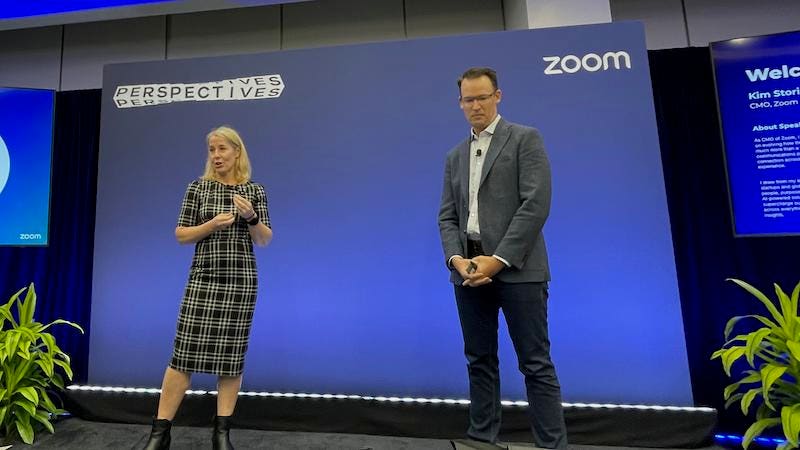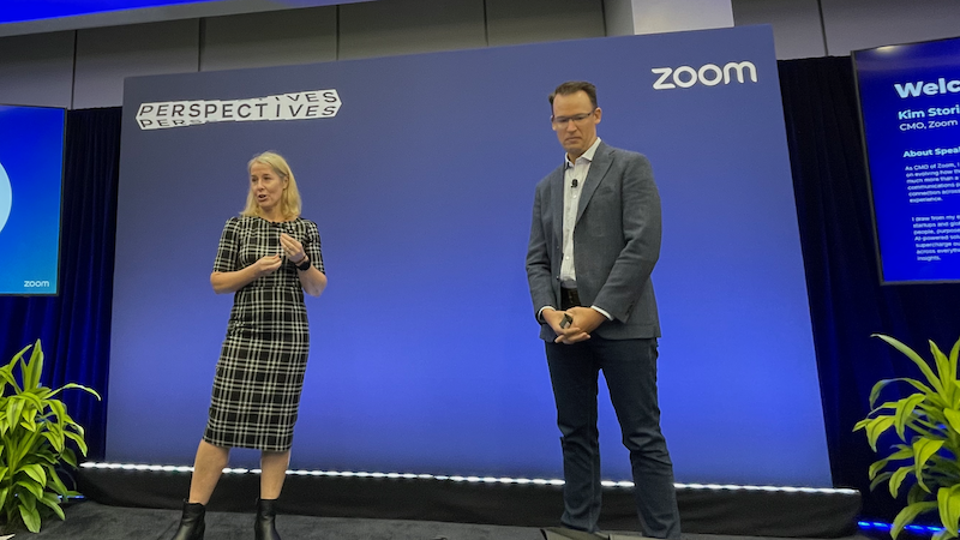Zoom CMO Kimberly Storin joins her colleague Graeme Geddes, chief sales and growth officer, onstage at Perspectives 2025 in San Jose.
Melody Brue
Zoom recently confronted a longstanding challenge: proving it is more than a video meetings provider.
At its Perspectives analyst event in late July, the company said its strategy is to pivot to being an AI-powered work platform, a shift CEO Eric Yuan summarized as a plan to “disrupt itself.” This move combines communications, productivity and customer engagement tools into a technology suite built around agentic AI, digital assistants and digital twins, all designed to help users move “from conversation to completion,” in a phrase used by Yuan and echoed by other company executives.
This integration of tools is central to Zoom’s strategy as it works to shift its product identity from a meeting app to a more complete platform for enterprise workflows. For example, Yuan’s appearance as a digital avatar during a recent earnings call was certainly flashy for the setting and effectively grabbed attention. While it could have come across as a gimmick to some, it ultimately conveyed the company’s intent to demonstrate how it has put its latest innovations into action. (Note: Zoom is an advisory client of my firm, Moor Insights & Strategy.)
As is typical with analyst events like this, Zoom held a significant portion of the Perspectives event under NDA, using the occasion as a controlled setting to test its messaging and fine-tune forthcoming strategic announcements. Many of the most substantial product updates — including developments in AI Companion, Custom AI Companion, Zoom Phone, Contact Center and Workvivo — remain embargoed until Zoomtopia, the company’s annual flagship event held in September, which will be all-virtual this year. (More on the challenges that could stir up later.)
Managing Product Complexity And User Experience
As Zoom broadens its platform, expectations for clarity and intuitiveness are also rising. The company’s rapid cadence of feature releases, especially vertical-specific solutions for sectors such as healthcare and frontline work, has led to reports of tool fatigue, with users sometimes struggling to identify which solution to use.
To counter this, Zoom has an opportunity to deploy its AI not just for automation, but also to provide more intelligent recommendations within the product itself that guide users and system admins to the most relevant workflows. This would help maximize value and reduce complexity for customers, while also reinforcing the tangible utility of Zoom’s AI investments.
Addressing Event Engagement And Community Building
This year, the absence of an in-person Zoomtopia could exacerbate ongoing challenges in user engagement and brand immersion. While a virtual event may be logistically easier, it cannot provide the same value as a live gathering, which fosters spontaneous peer networking and direct access to executives. Based on their experiences in hosting regional community events, companies including Box (with its BoxWorks roadshows), Canva (with its Community Labs) and Avaya (with its Journeys global roadshow) have found that localized, face-to-face interactions build user loyalty more effectively than purely digital experiences. Avaya’s events, for instance, connect customers with company leaders and key technology partners, including RingCentral and Verint, for hands-on learning about optimizing the ROI of AI.
Zoom has made some progress with its own Experience Centers, which are 18,000-plus-square-foot flagship facilities in regional locations (San Jose in California, London and Tokyo, with plans for additional locations) that feature advanced LED walls, interactive showcases and customized demonstration spaces for executive briefings and product testing. While these centers do provide immersive product demonstrations and opportunities for executive engagement, they are obviously also limited to people who can attend those specific locations. By expanding in-person experiences — either by building more Experience Centers or by introducing regular regional events — Zoom could reach a wider audience and capture some of the benefits that flagship gatherings offer in areas where a physical presence is currently lacking.
Sharpening Brand And Market Positioning With A New CMO
Zoom’s appointment of Kimberly Storin as chief marketing officer in April seemed to mark a turning point toward better communication. Her long experience guiding enterprise go-to-market strategies positions her as a crucial bridge between technology innovations and customer needs. Storin has a strong background in leadership roles at major companies, including IBM, AMD and Zayo Group. Her current challenge is to shift the brand narrative from simply celebrating connectedness to clearly articulating tangible improvements in performance, ROI and workflows.
This new focus should help Zoom’s value proposition resonate with end users and decision makers alike. So far, Storin’s approach reflects her acknowledgement that, while many remember Zoom’s vital role for connecting people during the pandemic, future buying decisions by companies will be driven by demonstrable business impact and efficiency gains.
One strategic mandate is to evolve the brand’s messaging. While the company’s past “Work Happy” call to action was emotionally resonant, its relentlessly upbeat tone could create an annoying and jarring disconnect in high-stakes or sensitive business conversations. In my conversations with her at Perspectives, Storin shared that she aims to retain that positive brand equity while also developing a more sophisticated narrative that focuses on tangible benefits for workers and the productivity gains that enterprise buyers demand.
How Zoom Is Competing For Enterprise Relevance
Operational improvements, such as enhancements to the Zoom Up Partner Program and ecosystem integrations with key third-party apps such as ServiceNow, are helping the company reach new customer segments and, in my view as an industry analyst, cementing its status among leading UCaaS providers. Its federated AI approach, which enables workflows that flexibly connect to the best available language models or automation for the task, reflects its increasingly open and interoperable strategy. As competition from Microsoft, Google and Cisco intensifies, Zoom must back up product differentiation with crystal-clear communication and easy activation for customers.
Now, Zoom Must Execute On Its Vision
Zoom’s path forward depends on whether users and buyers can clearly see and realize the benefits of its rapidly expanding offerings. The combination of accelerated product development, thoughtful AI-driven guidance, more intentional in-person engagement and stronger brand communication could unify its value proposition beyond the “video company” label. If executed well, these moves should not only help Zoom maintain its existing base. They could help it set a new benchmark for how AI-powered collaboration platforms are adopted and valued.
Moor Insights & Strategy provides or has provided paid services to technology companies, like all tech industry research and analyst firms. These services include research, analysis, advising, consulting, benchmarking, acquisition matchmaking and video and speaking sponsorships. Of the companies mentioned in this article, Moor Insights & Strategy currently has (or has had) a paid business relationship with AMD, Avaya, Box, Cisco, Google, IBM, Microsoft, RingCentral and Zoom.









